+ Open data
Open data
- Basic information
Basic information
| Entry | Database: PDB / ID: 5n6w | ||||||
|---|---|---|---|---|---|---|---|
| Title | Retinoschisin R141H Mutant | ||||||
 Components Components | Retinoschisin | ||||||
 Keywords Keywords | STRUCTURAL PROTEIN / Retinoschisin Discoidin Domain Retinal Structure | ||||||
| Function / homology |  Function and homology information Function and homology informationneuron to neuron synapse / retina layer formation / eye development / phosphatidylinositol-3,4-bisphosphate binding / phosphatidylserine binding / photoreceptor inner segment / visual perception / protein homooligomerization / cell adhesion / external side of plasma membrane ...neuron to neuron synapse / retina layer formation / eye development / phosphatidylinositol-3,4-bisphosphate binding / phosphatidylserine binding / photoreceptor inner segment / visual perception / protein homooligomerization / cell adhesion / external side of plasma membrane / protein-containing complex binding / protein-containing complex / extracellular space Similarity search - Function | ||||||
| Biological species |  Homo sapiens (human) Homo sapiens (human) | ||||||
| Method | ELECTRON MICROSCOPY / single particle reconstruction / cryo EM / Resolution: 4.2 Å | ||||||
 Authors Authors | Ramsay, E.P. / Collins, R.F. / Owens, T.W. / Siebert, C.A. / Jones, R.P.O. / Roseman, A. / Wang, T. / Baldock, C. | ||||||
| Funding support |  United Kingdom, 1items United Kingdom, 1items
| ||||||
 Citation Citation |  Journal: Hum Mol Genet / Year: 2016 Journal: Hum Mol Genet / Year: 2016Title: Structural analysis of X-linked retinoschisis mutations reveals distinct classes which differentially effect retinoschisin function. Authors: Ewan P Ramsay / Richard F Collins / Thomas W Owens / C Alistair Siebert / Richard P O Jones / Tao Wang / Alan M Roseman / Clair Baldock /  Abstract: Retinoschisin, an octameric retinal-specific protein, is essential for retinal architecture with mutations causing X-linked retinoschisis (XLRS), a monogenic form of macular degeneration. Most XLRS- ...Retinoschisin, an octameric retinal-specific protein, is essential for retinal architecture with mutations causing X-linked retinoschisis (XLRS), a monogenic form of macular degeneration. Most XLRS-associated mutations cause intracellular retention, however a subset are secreted as octamers and the cause of their pathology is ill-defined. Therefore, here we investigated the solution structure of the retinoschisin monomer and the impact of two XLRS-causing mutants using a combinatorial approach of biophysics and cryo-EM. The retinoschisin monomer has an elongated structure which persists in the octameric assembly. Retinoschisin forms a dimer of octamers with each octameric ring adopting a planar propeller structure. Comparison of the octamer with the hexadecamer structure indicated little conformational change in the retinoschisin octamer upon dimerization, suggesting that the octamer provides a stable interface for the construction of the hexadecamer. The H207Q XLRS-associated mutation was found in the interface between octamers and destabilized both monomeric and octameric retinoschisin. Octamer dimerization is consistent with the adhesive function of retinoschisin supporting interactions between retinal cell layers, so disassembly would prevent structural coupling between opposing membranes. In contrast, cryo-EM structural analysis of the R141H mutation at ∼4.2Å resolution was found to only cause a subtle conformational change in the propeller tips, potentially perturbing an interaction site. Together, these findings support distinct mechanisms of pathology for two classes of XLRS-associated mutations in the retinoschisin assembly. | ||||||
| History |
|
- Structure visualization
Structure visualization
| Movie |
 Movie viewer Movie viewer |
|---|---|
| Structure viewer | Molecule:  Molmil Molmil Jmol/JSmol Jmol/JSmol |
- Downloads & links
Downloads & links
- Download
Download
| PDBx/mmCIF format |  5n6w.cif.gz 5n6w.cif.gz | 819 KB | Display |  PDBx/mmCIF format PDBx/mmCIF format |
|---|---|---|---|---|
| PDB format |  pdb5n6w.ent.gz pdb5n6w.ent.gz | 675.5 KB | Display |  PDB format PDB format |
| PDBx/mmJSON format |  5n6w.json.gz 5n6w.json.gz | Tree view |  PDBx/mmJSON format PDBx/mmJSON format | |
| Others |  Other downloads Other downloads |
-Validation report
| Summary document |  5n6w_validation.pdf.gz 5n6w_validation.pdf.gz | 1.1 MB | Display |  wwPDB validaton report wwPDB validaton report |
|---|---|---|---|---|
| Full document |  5n6w_full_validation.pdf.gz 5n6w_full_validation.pdf.gz | 1.1 MB | Display | |
| Data in XML |  5n6w_validation.xml.gz 5n6w_validation.xml.gz | 70.1 KB | Display | |
| Data in CIF |  5n6w_validation.cif.gz 5n6w_validation.cif.gz | 91.1 KB | Display | |
| Arichive directory |  https://data.pdbj.org/pub/pdb/validation_reports/n6/5n6w https://data.pdbj.org/pub/pdb/validation_reports/n6/5n6w ftp://data.pdbj.org/pub/pdb/validation_reports/n6/5n6w ftp://data.pdbj.org/pub/pdb/validation_reports/n6/5n6w | HTTPS FTP |
-Related structure data
| Related structure data |  3595MC M: map data used to model this data C: citing same article ( |
|---|---|
| Similar structure data |
- Links
Links
- Assembly
Assembly
| Deposited unit | 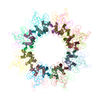
|
|---|---|
| 1 |
|
- Components
Components
| #1: Protein | Mass: 23041.902 Da / Num. of mol.: 16 / Mutation: R141H Pathogenic Mutation Source method: isolated from a genetically manipulated source Source: (gene. exp.)  Homo sapiens (human) / Gene: RS1, XLRS1 / Plasmid: pCEP-Pu/Ac7 / Cell line (production host): HEK293-EBNA / Production host: Homo sapiens (human) / Gene: RS1, XLRS1 / Plasmid: pCEP-Pu/Ac7 / Cell line (production host): HEK293-EBNA / Production host:  Homo sapiens (human) / References: UniProt: O15537 Homo sapiens (human) / References: UniProt: O15537Has protein modification | Y | |
|---|
-Experimental details
-Experiment
| Experiment | Method: ELECTRON MICROSCOPY |
|---|---|
| EM experiment | Aggregation state: PARTICLE / 3D reconstruction method: single particle reconstruction |
- Sample preparation
Sample preparation
| Component | Name: Retinoschisin / Type: COMPLEX Details: Hexadecameric complex of sixteen retinoschisin molecules Entity ID: all / Source: RECOMBINANT | |||||||||||||||
|---|---|---|---|---|---|---|---|---|---|---|---|---|---|---|---|---|
| Molecular weight | Experimental value: NO | |||||||||||||||
| Source (natural) | Organism:  Homo sapiens (human) Homo sapiens (human) | |||||||||||||||
| Source (recombinant) | Organism:  Homo sapiens (human) / Cell: HEK293-EBNA / Plasmid: pCEP-Pu/Ac7 Homo sapiens (human) / Cell: HEK293-EBNA / Plasmid: pCEP-Pu/Ac7 | |||||||||||||||
| Buffer solution | pH: 7.4 | |||||||||||||||
| Buffer component |
| |||||||||||||||
| Specimen | Conc.: 0.1 mg/ml / Embedding applied: NO / Shadowing applied: NO / Staining applied: NO / Vitrification applied: YES / Details: The sample was monodisperse and visible | |||||||||||||||
| Specimen support | Grid material: COPPER / Grid mesh size: 400 divisions/in. / Grid type: C-flat-2/2 | |||||||||||||||
| Vitrification | Instrument: FEI VITROBOT MARK I / Cryogen name: ETHANE / Humidity: 100 % / Chamber temperature: 277 K |
- Electron microscopy imaging
Electron microscopy imaging
| Experimental equipment |  Model: Titan Krios / Image courtesy: FEI Company |
|---|---|
| Microscopy | Model: FEI TITAN KRIOS |
| Electron gun | Electron source:  FIELD EMISSION GUN / Accelerating voltage: 300 kV / Illumination mode: SPOT SCAN FIELD EMISSION GUN / Accelerating voltage: 300 kV / Illumination mode: SPOT SCAN |
| Electron lens | Mode: BRIGHT FIELD / Nominal magnification: 105000 X / Nominal defocus max: 4500 nm / Nominal defocus min: 1000 nm / Cs: 2.7 mm / Alignment procedure: COMA FREE |
| Specimen holder | Cryogen: NITROGEN / Specimen holder model: FEI TITAN KRIOS AUTOGRID HOLDER |
| Image recording | Average exposure time: 0.5 sec. / Electron dose: 2.8 e/Å2 / Detector mode: COUNTING / Film or detector model: GATAN K2 SUMMIT (4k x 4k) / Num. of grids imaged: 1 / Num. of real images: 1200 |
| Image scans | Movie frames/image: 14 / Used frames/image: 2-8 |
- Processing
Processing
| EM software |
| ||||||||||||||||||||||||||||||||||||
|---|---|---|---|---|---|---|---|---|---|---|---|---|---|---|---|---|---|---|---|---|---|---|---|---|---|---|---|---|---|---|---|---|---|---|---|---|---|
| CTF correction | Type: PHASE FLIPPING AND AMPLITUDE CORRECTION | ||||||||||||||||||||||||||||||||||||
| Symmetry | Point symmetry: D8 (2x8 fold dihedral) | ||||||||||||||||||||||||||||||||||||
| 3D reconstruction | Resolution: 4.2 Å / Resolution method: FSC 0.143 CUT-OFF / Num. of particles: 7056 / Symmetry type: POINT | ||||||||||||||||||||||||||||||||||||
| Atomic model building | Protocol: FLEXIBLE FIT / Target criteria: Cross-correlation coefficient |
 Movie
Movie Controller
Controller





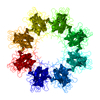
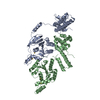
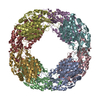
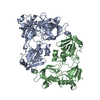
 PDBj
PDBj

